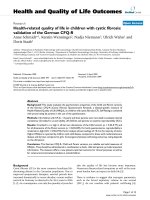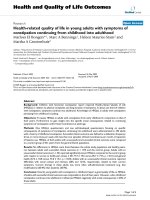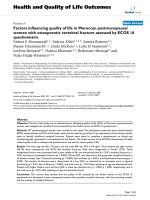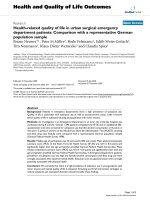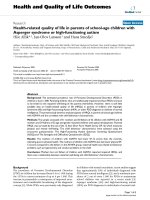Báo cáo y học: "Sustained High Quality of Life in a 5-Year Long Term Follow-up after Successful Ablation for Supra-Ventricular Tachycardia. Results from a large Retrospective Patient Cohort"
Bạn đang xem bản rút gọn của tài liệu. Xem và tải ngay bản đầy đủ của tài liệu tại đây (922.05 KB, 9 trang )
Int. J. Med. Sci. 2009, 6
28
I
I
n
n
t
t
e
e
r
r
n
n
a
a
t
t
i
i
o
o
n
n
a
a
l
l
J
J
o
o
u
u
r
r
n
n
a
a
l
l
o
o
f
f
M
M
e
e
d
d
i
i
c
c
a
a
l
l
S
S
c
c
i
i
e
e
n
n
c
c
e
e
s
s
2009; 6(1):28-36
© Ivyspring International Publisher. All rights reserved
Research Paper
Sustained High Quality of Life in a 5-Year Long Term Follow-up after Suc-
cessful Ablation for Supra-Ventricular Tachycardia. Results from a large
Retrospective Patient Cohort
Axel Meissner
1
, Irini Stifoudi
1
, Peter Weismüller
2
, Max-Olav Schrage
1
, Petra Maagh
1
, Martin Christ
1
,
Thomas Butz
1
, Hans-Joachim Trappe
1
, Gunnar Plehn
1
1. Department of Cardiology and Angiology, Ruhr-University Bochum, Germany
2. Department of Cardiology and Angiology, General Hospital Hagen, Germany
Correspondence to: Dr. med. Axel Meissner, Medizinische Klinik II, Schwerpunkte Kardiologie und Angiologie,
Ruhr-Universität Bochum, Hölkeskampring 40, 44625 Herne. Tel: 02323-499-1600; Fax: 02323-499-301; e-mail:
axel.meissner@ruhr-universität-bochum.de
Received: 2008.12.09; Accepted: 2009.01.09; Published: 2009.01.11
Abstract
Introduction: The ablation of supraventricular tachycardias (SVT) using radiofrequency en-
ergy (RF) is a procedure with a high primary success rate. However, there is a scarcity of
data regarding the long term outcome, particularly with respect to quality of life (QoL).
Methods and Results: In this retrospective single-center study, 454 patients who under-
went ablation of SVT between 2002 and 2007 received a detailed questionnaire addressing
matters of QoL. The questionnaire was a modified version of the SF-36 Health Survey
questionnaire and the Symptom Checklist – Frequency and Severity Scale.
After a mean follow up of 4.5±1.3 years, 309 (68.1%) of the contacted 454 patients (269
female, 59.2%, mean age 58+/-6.5) completed the questionnaire. Despite of 27% of relapses
in the study group, 91.7% considered the procedure a long-term success. The remainder of
patients experienced no change in (3.7%) or worsening of (4.7%) symptoms. There were no
significant differences between the various types of SVT (p=1). QoL in patients with
Atrio-Ventricular Nodal Reentry Tachycardia (AVNRT) and Atrio-Ventricular Reentry
Tachycardia (AVRT) improved significantly (p<0.0005 respectively p<0.043), whereas QoL in
patients with Ectopic Atrial Tachycardia (EAT) showed a non-significant trend towards im-
provement. Main symptoms before ablation, such as tachycardia (91.5%), increased incidence
of tachycardia episodes over time (78.1%), anxiety (55.5%) and reduced physical capacity in
daily life (52%) were significantly improved after ablation (p<0.0001).
Conclusion: The high acute ablation success of SVT persists for years in long term follow up
and translates into a significant improvement of QoL in most patients.
Key words: Quality of Life, Ablation, SVT, Atrium, Radio Frequency
Introduction
RF catheter ablation of SVT is a well-established
treatment in invasive electrophysiology with a pri-
mary success rate of more than 90% in all substrates.
SVT ablation specifically targets the electroanatomical
substrate, such as the slow pathway in AVNRT, the
accessory pathway in AVRT or an ectopic focus in
EAT.
Oftentimes, these specific SVT are difficult to
treat medically due to therapy refractoriness. There-
fore, RF ablation has become the treatment of choice
Int. J. Med. Sci. 2009, 6
29
due to its high primary success rate and low compli-
cation rate (1-6).
Patients with paroxysmal SVT often present with
symptoms like palpitations, dyspnea, fatigue, chest
pain or worsening of heart failure under physical or
emotional stress. Heart rates of 200 beats per minute
and more are not uncommon, especially in young
patients or in patients with AVRT and associated
atrial fibrillation (AF). Recurrent syncope or other
life-threatening complications like ventricular tachy-
cardia and/or ventricular fibrillation may occur.
Due to the paroxysmal character of the tachy-
cardia, with sudden unexpected onset of symptoms,
patients are limited in their daily life concerning
work, social events and sports. Due to this nature of
the disease QoL is increasingly impaired over time.
Despite of the high immediate success rate of SVT
catheter ablation, very little data is available con-
cerning the development of QoL in the long-term. The
published literature mainly deals with the electro-
physiological long term results of RF ablation. So far,
QoL before and after ablation has not been system-
atically investigated in these patients (7-13). In con-
trast, other SVT like atrial flutter and AF have been
intensively investigated under this aspect (14-23).
Methods
Study population
All patients included either had a typical history
of a paroxysmal on-off tachycardia or documented
narrow complex SVT pattern in a twelve lead ECG.
They consecutively underwent an electrophysiologi-
cal study. If an AVNRT, AVRT or EAT could be in-
duced and ablated with primary success, patients
were later selected for participation in this retrospec-
tive single-center study.
All 454 patients, (59.2% female, 40.8% male,
mean age 58 (+/- 16.5) years) who had undergone RF
catheter ablation for AVNRT, AVRT or EAT at our
institution between 2002 and 2007 were mailed a de-
tailed questionnaire. This questionnaire was a version
of the SF-36 Health Survey questionnaire and the
Symptom Checklist–Frequency and Severity Scale,
modified to specifically reflect questions of QoL in
SVT, enabling the authors to translate the various
domains and components of well being into a quan-
titative value.
For reasons of structure and to simplify an-
swering for the patients we divided the questionnaire
in three different blocks: the first block was related to
the situation for the patients before ablation, questions
in the second block dealt with the situation during
ablation and the third block exclusively applied to the
post ablation period.
The modified version of the SF-36 consists of a 36
item questionnaire that assesses eight health concepts:
general health perception, physical functioning, social
functioning, role limitations due to physical problems,
bodily pain, mental health, role limitations due to
emotional problems, and vitality. In addition the
SF-36 also generates physical and mental component
summery scores.
Irrespective of the well known shortcomings of
the Symptom checklist because of the nonspecific
nature of a number of the symptoms asked for and the
lack of assessment of functional status the Symptom
checklist is straightforward to use, sensitive to change,
and has been utilized in a growing number of studies
concerning arrhythmias. We asked for specific
symptoms e.g. as tachycardia, palpitations, dyspnea,
anxiety and angina pectoris.
If no response had been received after 4 weeks,
the patients were contacted by telephone and asked to
participate. 309 (68.1%) of the contacted 454 patients
fully completed the questionnaire. 145 (31.9%) pa-
tients had to be excluded due to incomplete or inco-
herent answers or because they completely failed to
participate. Patients suffering from new palpitations
and SVT were contacted for a second time and were
asked to additionally submit a recent 12 lead ECG for
analysis.
Electrophysiological study and radiofrequency
catheter ablation
In all patients, a standard setting with four di-
agnostic catheters was used (high right atrium, HIS
bundle region, right ventricular apex and coronary
sinus). Before ablation, the underlying clinical tachy-
cardia had to be able to be repeatedly induced before
detailed mapping and the ablation maneuvers were
performed. The ablation itself was performed in sinus
rhythm in most cases or under continuing tachycar-
dia, if so required for mapping.
The ablation itself was performed using either an
irrigated tip or a conventional tip ablation catheter.
Successful ablation was defined as the
non-reinducibility of the native tachycardia or the loss
of the delta wave in AVRT. Subsequently, further
electrophysiological testing for additional tachycar-
dias, which could potentially have been masked by
the now ablated primary tachycardia, was performed.
The aforementioned endpoints were re-evaluated
after a waiting period of at least 20 minutes.
Statistical Analysis
For the description of the metric variables the
results are expressed as number, mean, standard de-
Int. J. Med. Sci. 2009, 6
30
viation (SDA) and extreme (minimum and maxi-
mum), quartile (25. and 75. percentile) and median.
The distribution of categorical data is expressed by
absolute and relative frequency.
The comparison of the distribution of the cate-
gorical variables before and after ablation concerning
two variables was expressed by the McNemar Test.
More than two variables were compared using the
Chi-square-distribution. For the comparison of the
distribution of categorical and ordinal variables of
independent random samplings we used Fisher’s ex-
act test. If the Gaussian distribution acceptation was
declined, we used a non-parametric test for differ-
ences in groups the Mann Whitney U Test or the
Kruskal-Wallis-Test, otherwise the t- or F-test.
Results
Study population
309 (68.1%) patients were included into the
study. In 230 of the 309 patients the SVT substrate was
an AVNRT (74.4%), in 66 patients an AVRT (21.4%)
and in 13 patients an EAT (4.2%). The distribution
between the sexes (female/male) in AVNRT was
62.2/37.8, in AVRT 50/50 and in EAT 53.9/46.2. Mean
age was 58 (±16.5) for the whole study group, 62
(±15.3) for AVNRT, 48 (±17.6) for AVRT and 63 (±13.3)
for EAT. With respect to the underlying tachycardia,
66.9% of patients with AVNRT, 75% of patients with
AVRT and 59.1% of patients with EAT respectively
submitted a fully completed questionnaire.
Time to diagnosis, time to ablation, baseline data
of ablation
Regarding the time interval between the first
occurrence of the tachycardia, its diagnosis and the
year of ablation, we found significant differences.
Regarding the whole study cohort, the underlying
SVT was diagnosed 9.1±11.2 years (25%/75% percen-
tile – 1.0/15.0) and ablated 14.4±12.7 years (25%/75%
percentile – 3.0/24.0) after the first episode of tachy-
cardia. These time intervals (time to diagnosis/time to
ablation) differed between the specific SVT (Table 1).
The time interval between the first occurrence of the
tachycardia and the diagnosis in AVRT was therefore
significantly shorter compared to the AVNRT patients
(p<0.05); however, the earlier diagnosis of AVRT did
not lead to earlier ablation as well.
Baseline data of the ablation procedure compar-
ing the number of RF burns, the total examination
time and the fluoroscopy duration are summarized in
Table 1. There were no significant differences between
the different types of SVT.
Table 1: Baseline demographic characteristics and pro-
cedural findings in 309 patients with completed question-
naire.
Patients Numbers/percentage
Patients included 309 – 68%
Female 269 – 59%
Male 185 – 41%
AVNRT 230 – 74%
AVRT 66 – 66%
EAT 13 – 4%
From symptom to diagnosis (Years) Total – 25%/75% perc.
All patients 9.1±11.2 – 1.0/15.0
AVNRT 10.3±11.9 – 1.0/18.0
AVRT 4.7±7.2 – 0.0/9.0
EAT 7.5±8.7 – 0.0/18.0
From symptom to ablation (Years)
All patients 14.4±12.7 – 3.0/24
AVNRT 15.0±13.3 – 3.0/25.0
AVRT 12.3±10.0 – 3.0/20
EAT 10.9±7.4 – 6.0/18.0
RF-Applications (Number)
All patients 7.3±6.7 – 3.0/8.5
AVNRT 7.4±6.9 – 3.0/8.0
AVRT 6.8±6.5 – 2.0/10
EAT 8.0±3.6 – 6.0/9.0
Examination time (Minutes)
All patients 141.3±55.6 – 100/170
AVNRT 134.3±52.4 – 96/160
AVRT 156.1±58.7 – 117.5/193.5
EAT 189.5±59.7 – 135/240
Fluoroscop time (Minutes)
All patients 19.0±13.9 – 10.8/22.8
AVNRT 16.4±11.0 – 10.4/19.2
AVRT 25.5±19.2 – 12.3/31.9
EAT
30.5±11.4 – 21.7/35.1
Quality of life and specific symptoms due to
tachycardia prior to ablation
In the questionnaire, all patients were asked to
state their symptoms and grade them on a severity
scale. We inquired about the nature and quantity of
tachycardia and the associated symptoms. Further-
more, the effect of symptoms on the patients` daily
and social life, especially with respect to abstinence
from work, sports and hobbies was surveyed.
Patients were asked to assess the changes in
daily and social life prior to the ablation procedure
itself using a 5-level ranking scale (extreme, very
strong, strong, moderate, low). In total, more than
60% of the patients (178, 60.7%) stated a strong to ex-
treme impairment in daily life, whereas the rest of the
patients (94, 29.3%) indicated only moderate or little
changes due to the tachycardia. The detailed results
are listed in Table 2.
Int. J. Med. Sci. 2009, 6
31
Table 2: Distribution of symptoms prior to ablation for
AVNRT-, AVRT-and EAT patients. Panel A: Quantity and
duration of episodes and the associated symptoms. Panel
B: Detraction in daily life generally and in parts of daily life.
AVNRT AVRT EAT
variable Value N % N % N %
PANAL A
Extreme 27 12.5 6 9.2 6 46.1
Very
strong
49 22.8 16 24.6 3 23.1
Strong 57 26.5 13 20.0 1 7.7
Moderate 46 21.4 10 15.4 2 15.4
Low 26 12.1 9 13.9 1 7.7
Detraction
in daily life
none 10 4.7 11 16.9 0 0
Yes 5 20.0 19 38.0 1 11.1 Limited in
Business/school
no 20 80.0 31 62.0 8 88.9
Yes 33 22.8 16 30.2 1 10.0 Limited in
sports
No 112 77.2 37 69.8 9 90.0
Yes 35 31.3 21 48.8 2 18.2 Limited in
hobbies
No 77 68.8 22 51.2 9 81.8
Yes 39 30.2 20 48.8 2 18.2 Limited in
Garden work
No 90 69.8 21 51.2 9 81.8
Yes 4 16.0 18 43.9 2 20.0 Limited in
Work at home
No 21 84.0 23 56.1 8 80.0
Yes 8 38.1 20 52.6 0 0 Limited in
Social life
No 13 61.9 18 47.4 9 100
Yes 70 30.4 9 13.6 6 46.2 Limited in
others
no 160 69.6 57 86.4 7 53.8
PANAL B
Extreme 27 12.5 6 9.2 6 46.1
Very
strong
49 22.8 16 24.6 3 23.1
Strong 57 26.5 13 20.0 1 7.7
Moderate 46 21.4 10 15.4 2 15.4
Low 26 12.1 9 13.9 1 7.7
Detraction
in daily life
none 10 4.7 11 16.9 0 0
Yes 5 20.0 19 38.0 1 11.1 Limited in
Business/school
no 20 80.0 31 62.0 8 88.9
Yes 33 22.8 16 30.2 1 10.0 Limited in
sports
No 112 77.2 37 69.8 9 90.0
Yes 35 31.3 21 48.8 2 18.2 Limited in
hobbies
No 77 68.8 22 51.2 9 81.8
Yes 39 30.2 20 48.8 2 18.2 Limited in
Garden work
No 90 69.8 21 51.2 9 81.8
Yes 4 16.0 18 43.9 2 20.0 Limited in
Work at home
No 21 84.0 23 56.1 8 80.0
Yes 8 38.1 20 52.6 0 0 Limited in
Social life
No 13 61.9 18 47.4 9 100
Yes 70 30.4 9 13.6 6 46.2 Limited in
others
no 160 69.6 57 86.4 7 53.8
Regarding the whole study population prior to
ablation, 305 patients (99.0%) had specific symptoms.
The main reasons for patients seeking therapy were
tachycardic palpitations (281 patients, 91.5%) and
increasing incidence of episodes (224 patients, 78.1%).
In descending order, patients as well complained of
anxiety (171 patients, 55.5%), reduced work capacity
(164 pts., 53.3%), dyspnea (138 patients, 44.8%) and
angina pectoris (137 patients, 44.5%). Symptoms such
as palpitations (77 patients, 25%), ophthalmic fibrilla-
tion (70 pts., 22.7%) and syncope (47 patients, 15.4%)
were relatively infrequent (Table 1, Figure 1).
Figure 1: Symptoms leading patients to therapy: X-axis:
Symptoms in declinary order. (1) Overall symptoms with-
out specification, (2) tachycardia, (3) increase of episodes
over the years, (4) anxiety, (5) reduction in capacity, (6)
dyspnea, (7) angina pectoris, (8) palpitations, (9) ophthalmic
fibrillation, (10) syncope. Y-axis: percentage of patients
presenting these symptom.
Ablation success rate
Independent of symptoms, the patients had to
rate the perceived success of the ablation procedure in
general (very successful, successful, moderately suc-
cessful or not successful). The majority of patients
rated the ablation procedure “very successful” or
“successful”. This is true for the whole study popula-
tion as well as for each SVT subgroup. Details are
given in Figure 2.
Figure 2: Satisfaction due to the ablation procedure.
X-axis: (1) All patients, (2) AVNRT, (3) AVRT, (4) EAT.
Pillars from left to right: very successful (black pillar), suc-
cessful (white pillar), moderate (dark grey), not successful
(light grey). Y-axis: Percentage of patients.
Int. J. Med. Sci. 2009, 6
32
Comparison of quality of life before and after
ablation
The general QoL and QoL with respect to the
above mentioned symptoms were retrospectively
evaluated before and after ablation. The aforemen-
tioned questionnaires included a section asking par-
ticipants to grade their well-being using a six-level
ranking scale (very good (1), good (2), satisfactory (3),
sufficient (4), defective (5) and insufficient (6)).
Patients with AVNRT, AVRT and EAT rated
their state of health before and after ablation. The
changes within the ranking scale before and after ab-
lation is demonstrated in Figure 3.
Figure 3: Comparison and improvement state of health before (black pillars) and after (white pillars) ablation. X-axis: State
of health ranking scale from 1 to 6: very good (1), good (2), satisfactory (3), sufficient (4), defective (5) and insufficient (6).
Y-axis: Percentage of patients Panel A: AVNRT. Panel B: AVRT. Panel C: EAT
Comparing the categorical variables before and
after ablation in AVNRT patients, applying the
McNemar-Test we found a highly significant im-
provement with respect to state of health (p<0.0005) in
this large patient group (Figure 3, Panel A). Regarding
the single aspects of well-being, we found highly sig-
nificant improvements in daily (hobbies and work at
home, p<0.0005) and social life (p<0.039). Professional

